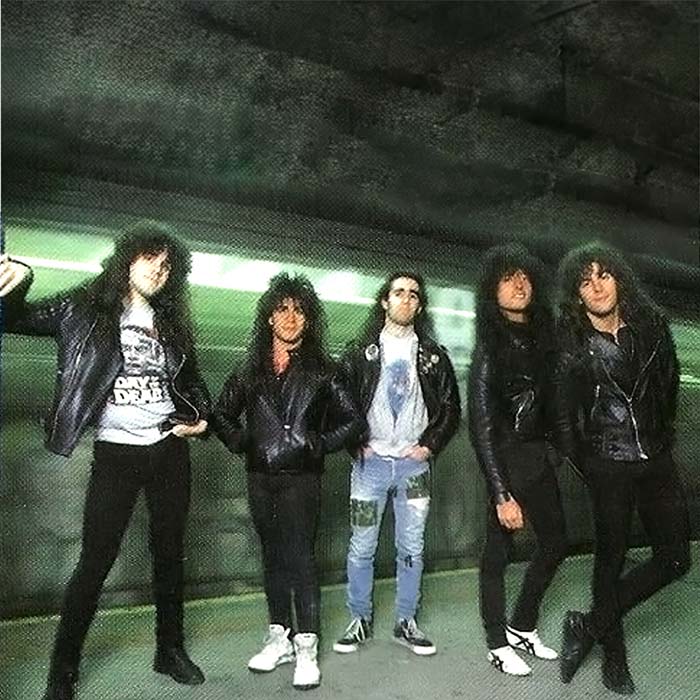In 1986, the year thrash evolved from a speedy branch of heavy metal into a genuine commercial phenomenon, Anthrax watched from the stage as its ear-splitting assault drove the Denver crowd to madness. Then, in founder Scott Ian’s words, “A kid climbed onstage and fucked up my pedalboard.” Guitar tech Artie Ring, fearing damage to Anthrax’s gear, went to toss the kid off the stage. Moments later, Ring found himself consumed by the fray, and when the battered and bruised roadie crawled out of his bunk the next day, he clutched his back in pain. The band asked what happened, and Ring replied “Oh, man, I got caught in a mosh.”
If you’ve ever been caught in a mosh, you recall the sheer physicality of the experience: the smell of spilled beer, the slap of flesh on flesh, the sweaty bodies bouncing against each other like atoms in a particle accelerator. Anthrax may not have invented the term “mosh,” but “Caught in a Mosh,” from the band’s 1987 breakthrough record Among the Living, helped popularize it. When played live, the song’s volatile tempos, frantic playing and ferocious blend of metal and hardcore punk become an instant call to action: form a pit, and leap into it.
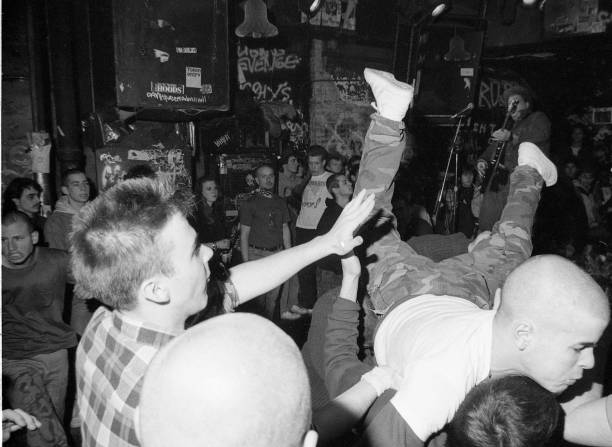
Though Anthrax has seen a rotating cast of members over the decades, Ian — the band’s rhythm guitarist — remains its immutable core. Originally born Scott Ian Rosenfeld to an Orthodox Jewish family, Ian (who later legally dropped his last name) grew up distant from religion, and after seeing The Who on TV, the nine-year-old picked up the guitar and became a devotee of rock music. As a teenager, he moved to Queens and attended Bayside High School, where he shared classes with a handful of fellow rock fans, several of whom expressed interest in playing heavy metal music.
Heavy metal, which was synonymous with the heavily distorted guitars that gave the genre its name, had become immensely impactful on both sides of the Atlantic in the years following the emergence of progenitors Led Zeppelin, Black Sabbath and Deep Purple. During the 1970s, American bands like KISS, Alice Cooper and Van Halen instilled an accessible pop context into the music; in contrast, next-generation English metal bands like Judas Priest, Motörhead and Iron Maiden leaned harder into heaviness, jettisoning blues melodies and syncopation in favor of deliberate beat stresses and quick rhythms. Both variations profoundly influenced Anthrax, which Ian formed with Bayside friend Dan Lilker in July 1981 upon graduation, taking the band’s name from the infectious disease commonly spread by contact with infectious animal products. (Ian learned about the malady from a classmate, and decreed it “sufficiently evil.”)
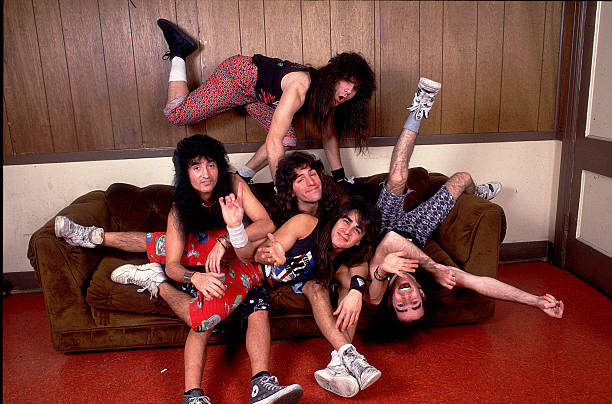
Ian and Lilker struggled to put together a consistent Anthrax lineup, with some members joining and leaving within a week, but by January 1984, fellow Bayside alumnus Neil Turbin had joined on vocals alongside lead guitarist Dan Spitz (of the early thrash band Overkill) and drummer Charlie Benante. This incarnation of the group recorded the full-length Fistful of Metal for indie label Megaforce Records, founded by Jon Zazula, the owner of tastemaking East Brunswick, N.J. record shop Rock’n Roll Heaven and an early proponent of thrash. Fistful of Metal sold relatively well considering Megaforce’s limited distribution capacity, but its real legacy lies in journalist Malcolm Dome’s inception of the term “thrash,” a moniker inspired by the LP’s second track, “Metal Thrashing Mad.”
A breakout tour followed in the spring of 1984, with Anthrax opening for Metallica (who had released its debut LP Kill ‘Em All on Megaforce months prior) and rising Newcastle heavy metal band Raven. Major labels took note of the tour’s success, and soon after Metallica signed to Elektra Records — a landmark moment in thrash’s commercial development — Anthrax and Megaforce secured a global distribution deal with Island Records ahead of 1985’s Spreading the Disease, which peaked at number 113 on the Billboard 200. With three days of studio time left to fill after completing the LP, Ian and Benante formed a side project, Stormtroopers of Death, to record Speak English or Die, fusing nascent thrash and hardcore punk to create what would become “crossover thrash.”
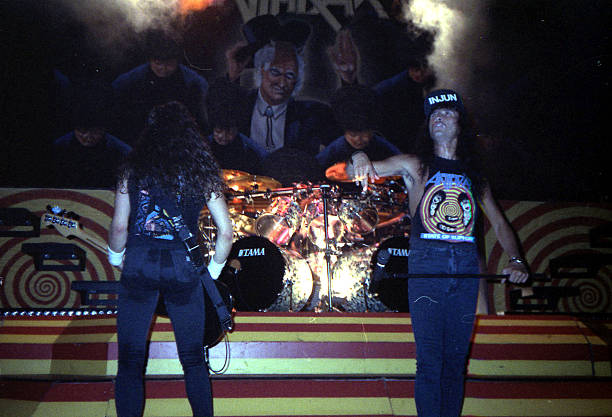
Anthrax may have bled metal, but with the exception of new singer Joey Belladonna — who preferred Iron Maiden and their ilk — they were also ardent proponents of hardcore. They watched the punk subgenre invade the East Coast underground after D.C. hardcore legends Bad Brains relocated to New York City and spurred the formation of bands like Beastie Boys, Cro-Mags, Agnostic Front and the Misfits. These hardcore bands differentiated themselves from those in other parts of the country by continuing the legacy of the Ramones, which applied a palm mute to Johnny Ramone’s iconic downstrums to create a style that acolytes dubbed “chug.” Hardcore audiences also practiced “slam dancing,” or the act of hurling bodies against each other during particularly intense songs, a phenomenon with roots in the punk act of “pogoing.” But where punk audiences jumped up and down in time with the beat, slam dancing was all horizontal collision. (According to legend, Bad Brains vocalist H.R. would command his audience to “mash” during their sets, and his Jamaican accent caused listeners, and eventually Rolling Stone, to interpret the order as “mosh.”)
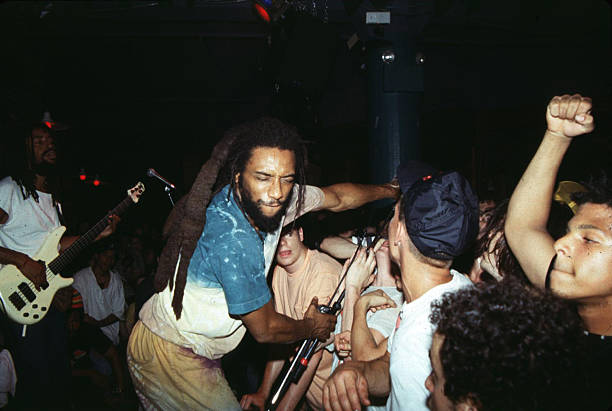
Speak English or Die telegraphed Ian’s and Betante’s intention to merge metal with hardcore, a mindset that inspired Among the Living, Anthrax’s third album, which arrived in the wake of a series of thrash milestones including Metallica’s Elektra debut Master of Puppets as well as Peace Sells… But Who’s Buying? (the major label bow from ex-Metallica guitarist Dave Mustaine’s new band Megadeth) and Slayer’s Reign in Blood. Among the Living, like its contemporaries, broadened the definition of what a thrash record could be: the tracks were still quite lengthy, and Belladonna still insisted on singing his lines a la Bruce Dickinson, but highlights like “Elifnikufecin (N.F.L.)” and “A Skeleton in the Closet” anchored themselves around blistering speeds and shout-sing backing vocals — touchstones of hardcore.

It’s surprising, then, that “Caught in a Mosh” was not released as a single: it’s not only the clearest example of Anthrax’s hardcore refashioning, but also one of the band’s most enduring cuts. “Caught in a Mosh” may not be the first song in history to incorporate the term into its title (that distinction also goes to Ian, who wrote Stormtroopers of Death’s “Milano Mosh”), but it still feels designed to whip its listeners into a frenzy. Moshing is not like other forms of dancing where people typically move to a beat or rhythm — it’s a release of energy incited by whatever music is blasting out of the stage speakers, and the harder it is to follow the beat, the easier it is to lose yourself to the fracas. It helps then that “Caught in a Mosh” frequently switches gears, like a teenager learning the stick shift. A measured guitar intro leads into Frank Bello’s bass outlining the chorus melody, which Betante accelerates as the band follows suit; Betante heightens the tempo again before Belladonna enters, thoroughly rejecting any concept of a consistent beat and signaling the commencement of the mosh.
Betante, also one of the principal “Caught in a Mosh” songwriters, is the not-so-secret weapon behind the song’s potency. “The idea behind it, musically, was built around AC/DC’s ‘Whole Lotta Rosie,’” he explained to Revolver in 2012. “I always wanted to write something with that tempo. It just made you want to get up and go and do something.” It’s unclear which specific tempo Betante’s talking about, but he’s correct in identifying the track as a recipe for movement. When he slows the pace down for the pre-choruses and again for the bridge, he provides launching pads for the crowd to begin slam dancing anew when the speed picks up.
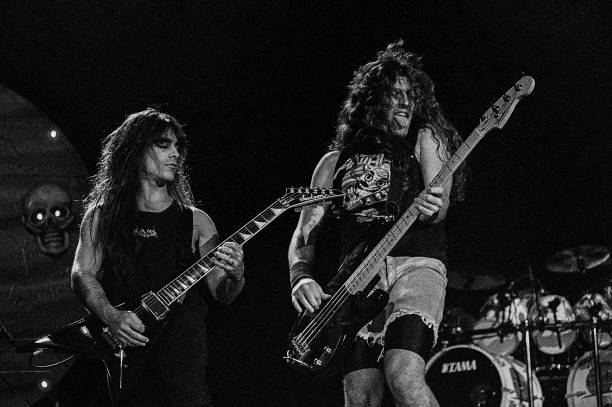
The dry, crisp sound of “Caught in a Mosh” comes courtesy of Eddie Kramer, a veteran engineer whose services the band specifically requested. “If you listen back to what he did in the Seventies, there’s a raw, real live feel to his production,” Ian explained to Malcolm Dome in 2016. “We wanted to keep everything right in your face on this record. We wanted to go against the norm of the time.” That norm was the full, hyper-produced sound of Def Leppard’s 1983 masterpiece Pyromania, bestowed by producer Robert John “Mutt” Lange. Kramer, on the other hand, had done wonders with recordings by Led Zeppelin and the Jimi Hendrix Experience (as well as Ian’s favorite, KISS), and considering Anthrax’s comfort in rehearsing live, he made for an obvious choice. Kramer did attempt a “modern,” Lange-inspired mix that the band immediately rejected, ensuring the material remained like a bag of flour — dry and heavy simultaneously.
Among the Living peaked at number 62 on the Billboard 200, and went on to sell over half a million copies in the U.S. alone. “That’s also the time when the phrase ‘The Big Four of Thrash’ was invented,” Ian recalled to Dome, who in fact coined the moniker. “Ourselves, Metallica, Megadeth and Slayer were all about the same age, and all around the same stage in our careers. It was a time when the whole thrash thing really took off, and I’d like to think that Among the Living helped.” (Anthrax dedicated the album to the memory of Metallica bassist Cliff Burton, who died in a 1986 bus accident while the two bands toured Sweden together.)
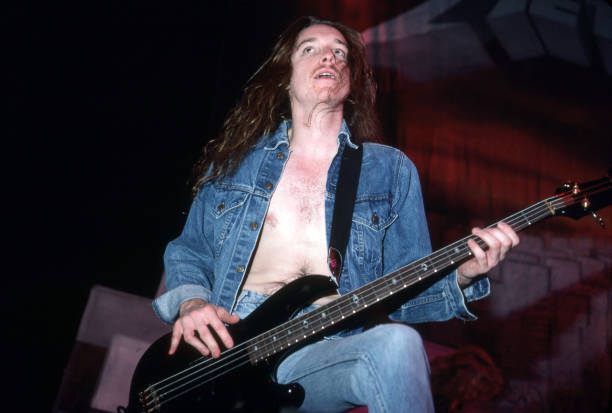
Anthrax celebrated its 40th anniversary in 2021, and while its longest-serving fans are perhaps a little too old to enter the mosh pit, they still come out in droves to celebrate the band’s music. Ian recommends that new listeners sample “Caught in a Mosh” to understand what Anthrax is all about.
“It’s like a greatest hits in one song,” he said to Revolver. “It’s got hardcore, it’s got rock, it’s got metal. It’s fast, it’s mid-tempo, it’s slow. It’s got everything.”

